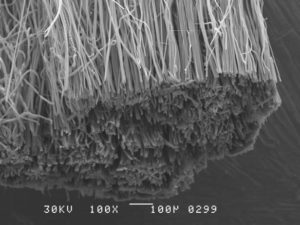Carbon fibers are about 5 to 10 micrometers (0.0002–0.0004 in) in diameter.
Why make them so thin?
In short, carbon fibers are manufactured through the stabilization, carbonization and graphitization of a precursor (generally polyacrylonitrile or petroleum pitch). The crystal structure of graphite consists of sp2 hybridized carbon atoms arranged two-dimensionally in a honeycomb structure in the x-y plane. The layers, termed graphene layers, are stacked parallel to each other in a 3D structure.
A precursor with a smaller fiber diameter allows for a higher graphitization degree. In other words, the carbon fiber will have greater graphite content. This way, the probability of having a concentration of defects in the 3D structure is considerably reduced. That is why the mechanical properties of fibers are inversely proportional to their filament diameter.

